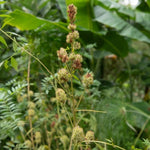Subscribe and save 10%!

Yunnan Liquorice Root (Glycyrrhiza yunnanensis)
45 SEK
Unit price perExpected delivery date: 20 December to 27 December.
Applies to orders within Sweden. For other countries - see our delivery terms .
In stock - Ready to be shipped
Share
45 SEK
Unit price perSEEDS (15pcs/bag)
Common name: Yunnan Liquorice/Licorice Root, Cultivated Licorice
Scientific name: Glycyrrhiza glabra
Family: Fabaceae
Plant history & use:
This characterizes Yunnan Liquorice Root in relation to other Liquorice species in the genus Glycyrrhiza:
- Originally from Yunnan Province in China.
- Has medical use in traditional Chinese medicine.
- Hardy down to -20 ºC. Slightly less cold-resistant than our other licorice root varieties.
- Thrives in moist and shady areas.
- Grows to a height of 1-2 meters.
Liquorice Root has a long history both as a medicinal plant and as a sweet treat. As early as 4000 BC it was used by the Assyrians and since then the licorice root has been used as a nerve-soother, flu-reliever, anti-infective and more.
One of the most prominent uses of the Licorice root by our ancestors was to chew it in order to keep their teeth clean and healthy. This was efficient due to the anti-bacterial properties of the substance glycyrrhizin present in the roots. It's also the same substance which provides the sweet flavor. However, glycyrrhizin is not metabolized by our bodies and may therefore, just as Stevia (Stevia rebaudiana), be used as a sweetening substitute for sugar.
Licorice root was sold in pharmacies as a medicine until as late as the 1970s.
The Licorice root can be shredded and made into a tea or a refreshening beverage served with ice. In Mongolia, the leaves are used as a substitute for common Tea (Camellia sinensis).
The root may also be ground/crushed to make your own licorice. Mix with sugar molasses/syrup, flour and anise in a heated saucepan.
Licorice root is also often used together with anise when flavoring alcoholic beverages.
Cultivation:
Licorice root grows naturally in southern Europe and parts of Asia.
The plant is hardy down to -20 ºC. In most of Europe, it can be grown outdoors all year round. To protect the plant during the winter, cover the base with twigs, leaves, straw or similar. Measures such as these can allow your Licorice root plant to thrive even in locations that are generally viewed as below its temperature range. The USDA Zone of the Licorice root range from 7-10.
Licorice root may also be grown in a wide pot, put outdoors during the warmer months, and indoors during the colder months.
Licorice root thrives best in well-drained soil and locations with full sun.
The roots, which are the main part used for consumption, become meters long, so a large pot is recommended for pot cultivation. It takes about 3 years for the plant to become harvestable and by that time it will likely have grown to become a fairly large bush.
Sowing:
The seeds can be sown directly outdoors when the soil temperature has risen to above 15 ºC. The seeds can also be pre-cultivated indoors any time of the year.
Soak the seeds for 1 day before sowing. Cover the seeds with a thin layer of soil and keep the sowing moist.
Characteristics:
Lifespan: Perennial
Location: Sun
Height: 1-2 m
Germination Time: 1-3 months
USDA Zone: 7-10
- Choosing a selection results in a full page refresh.
- Opens in a new window.






